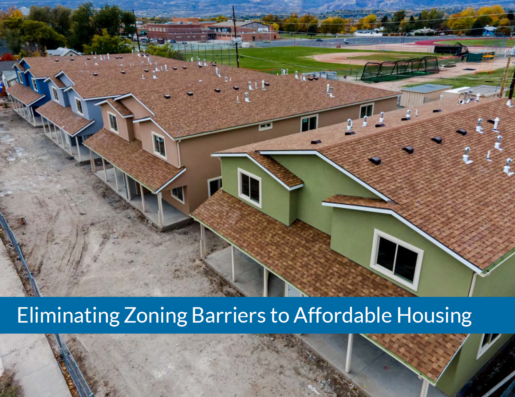Eliminating Zoning Barriers to Affordable Housing Guidebook
In response to the nation’s housing affordability crisis, many states, counties, and municipalities have enacted zoning reform to encourage and facilitate affordable housing choices. The Eliminating Zoning Barriers to Affordable Housing Guidebook provides practical and evidence-based solutions for practitioners seeking to address the housing supply and affordability crisis in their communities through zoning reform.
Audience and Objectives
In addition, this guidebook is relevant to other stakeholders able to directly influence, advocate for, or collaborate with planning personnel, such as:
- Community advocates
- Residents
- State leaders
- Housing developers
- Business leaders
It provides insights into how zoning impacts housing supply, which in turn impacts housing availability and affordability for rental and homeownership opportunities.
Most importantly, this guidebook provides a series of actionable regulatory, programmatic, and policy interventions that municipalities can employ to mitigate zoning barriers and advance the amount and variety of local affordable housing produced for all income levels.
Guidebook Structure
The guidebook is divided into six sections, including:
- Impact of Zoning Regulations on Housing Supply and Affordability
- Index of Housing Challenges and Solutions
- Stakeholders and Their Impacts on Advancing Zoning Reform
- Emerging Regulatory Solutions
- Additional Strategies and Solutions to Advance Affordable Housing Supply
- Case Studies
The Guidebook project was led by NALCAB and Smart Growth America.
This material is based upon work supported, in whole or in part, by Federal award number C-21-TA-TX-0010 awarded to the National Association for Latino Community Asset Builders by the U.S. Department of Housing and Urban Development. The substance and findings of the work are dedicated to the public. Neither the United States Government, nor any of its employees, makes any warranty, express or implied, or assumes any legal liability or responsibility for the accuracy, completeness, or usefulness of any information, apparatus, product, or process disclosed, or represents that its use would not infringe privately-owned rights. Reference herein to any individuals, agencies, companies, products, process, services, service by trade name, trademark, manufacturer, or otherwise does not constitute or imply an endorsement, recommendation, or favoring by the author(s), contributor(s), the U.S. Government, or any agency thereof. Opinions contained herein are those of the author(s) and do not necessarily reflect the official position of, or a position that is endorsed by, HUD or any Federal agency.
